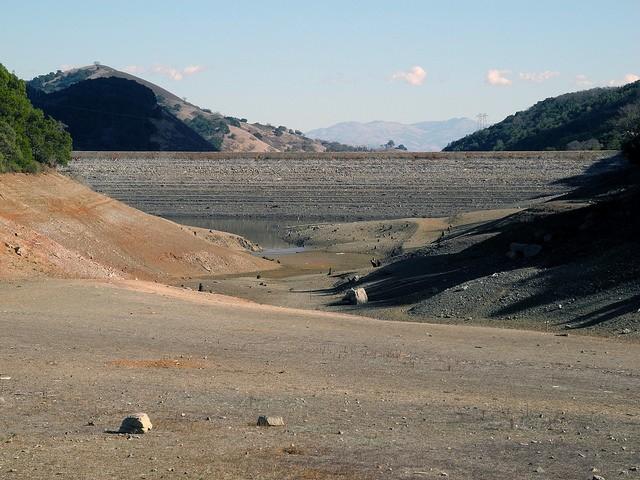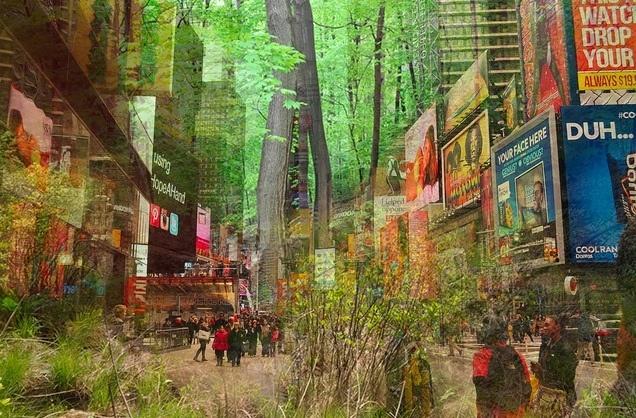Sustainable Economic Solutions to California's Drought


It seems my conservative friends can't send me enough articles on how environmentalists are the reason for California’s water crisis. These articles outline how environmentalists blocked the building of more reservoirs and forced the pumping of water from existing reservoirs to preserve river flows.
Increasingly, I'm also reading articles that propose solving California’s water crisis by reducing agricultural water use. These articles point out that California farmers consume 80 percent of the state’s water. In the interest of conserving water supplies, these articles discount the value of bringing water to California’s perfect climate and rich soil in order to sustain one of the world’s most productive food-growing regions. What they often ignore is pain that will be felt at the grocery store cash register and at food banks if California's farm production is curtailed due to a lack of water.
The California bottled water industry is really taking a public relations hit. Bottled water companies take water from California state’s parks for pennies and sell it for dollars. They not only sell California’s water in California but also outside the state. To a public concerned about water availability, this looks like profiteering at the expense of the common good.
California’s government sits at the center of the finger-pointing crossfire. State officials are proposing public policy alternatives for dividing water supplies among competing interests. Whatever they do will certainly generate hostile political action from the special interests that feel they are being squeezed out of their water supply.
A solution begins with a consensus on the cause of water scarcity
Finger-pointing will not relieve the pain of this drought or generate solutions. Environmentalists did not cause it to stop raining and snowing, which is the reason why California has a drought. Building more dams only works if there is snow-melt and rainfall to capture. Releasing dammed water supplies to maintain river flow may seem stupid -- unless you are downriver.
Blaming politicians can be therapeutic. However, California has a history of electing Republican and Democratic governors and legislators. None of these elected officials have found a large untapped water supply or have figured out how to make it rain and snow.
The answer to California’s drought has to come from building a consensus that water is a scarce resource and this scarcity is being made more intense by global warming created by human emissions of greenhouse gases. Droughts are not unique to California or the West. What makes this drought unique is its intensity. In recorded history, California has never received so little precipitation. Even when this current drought breaks the emerging research points to the entire West facing decades of mega-drought made more intense by global warming.
Sustainable solutions to drought
Sustainable answers are required to lessen the damage of this historic drought. The obvious long-term solution is to reduce human pollution, which has generated the climate change that has intensified droughts in California and the West. It will be interesting to see if the West gets thirsty enough to become a national political force for climate change solutions.
In the short terms, the answers have to be local. Communities and states have to develop public policy that rapidly accelerates efficient water use. Materially raising water prices (or taxes on water consumption) has to be a key part of this public policy. Increasing the price of water to its actual value during conditions of drought, while still protecting water affordability for lower-income individuals, is the sustainable economic solution. Doing so will generate intense consumer backlashes. But higher prices are the proven economic solution for achieving sustained changes in consumer behavior. Higher water prices will reduce consumption -- extending the availability of existing water supplies.
However, a higher cost for water will negatively impact California’s farmers and America’s food prices. Higher water prices will economically force farmers to curtail production or switch to less water-intensive crops like grapes. Higher water prices will also curtail California's oil production, which depends on well steam injection to sustain its position as America’s fourth largest oil producer. The net result of higher water prices will be higher food and pump prices. Jobs will be lost.
Looking past the finger-pointing at politicians, environmentalists and large water consumers, the economic reality is that higher pump prices, higher food prices and job losses are the emerging externality costs generated from manmade climate change. Ironically, many of the businesses and industries that will be economically impacted by higher water prices have strong culpability for creating climate change based on the scale of their fossil fuel emissions.
Higher prices alone, however, will not be enough to address the issue of water scarcity. The revenues generated from higher water prices and taxes must be used to fund investments that reduce water consumption and waste. Investment opportunities abound. California’s water system, like much of the country’s, is antiquated and leaks. This system needs to be replaced and repaired on a massive and accelerated scale.
Revenues should be used to pay cash subsidies in significantly large amounts to create economic incentives for homeowners and apartment owners to invest in drought-tolerant native plants and more water efficient end uses. Businesses should also be provided with attractive cash subsidies for investing in water-conserving equipment and technologies, as well as drought-tolerant landscaping.
Water desalination will grow in its adoption. This technology can produce significant amounts of drinkable water from sea water but at twice the cost of historical water supplies. The value of water under conditions of drought severity now supports the economics of desalination. However, desalination comes with another cost: Drinking water is generated through massive natural gas burning. Additional public policy will be needed to further accelerate adoption of energy efficiency and renewable energy in order to mitigate the greenhouse emissions generated through desalination.
Balancing conflicting interests in a scare resource environment
Answering the challenge of allocating a scarce resource requires solving for multiple equations. It goes beyond pointing fingers at farmers, enterprises, homeowners, environmentalists or politicians. Proposals like building more reservoirs do not fully grasp the reality that water in California and the Western U.S. is entering a historic phase of scarcity due to climate change.
This drought is now a graphic illustration that the economics of externally costs are just as real and measurable as pump, meter or cash register prices. Climate denial is not an economic “free lunch.” As climate deniers, and the rest of us, will soon experience: The cost of a drought made historically intense due to manmade climate change has very real and significantly-sized costs. These costs will include higher prices, job loss and a potential U.S. economic recession.
Image credit: Flickr/Ian Abbott
12 Risks That Can Disrupt Modern Supply Chains


By Ankit Kohli
Modern supply chains are characterized by close integration of suppliers with purchasing organizations, where suppliers are viewed as strategic partners who enable clients to add scale and capabilities, become more efficient and drive innovation. Therefore, it is not a surprise that supplier risk management is getting increased attention from the CPO’s office.
However, while supply chains have evolved over the past years, supplier risk assessments are still often equated with the unilateral approach of reviewing financial performance to ensure that suppliers are not staring at insolvency. But there is a fundamental problem with such assessments – they are post facto in nature, and are highly dependent on the financials reported by the supplier.
More importantly, such financial assessments point only to the symptoms (financial health indicators), but fail to identify the causes (underlying business conditions) that actually result in deterioration of a supplier’s financial health. As a result, by the time financial performance of a supplier hints at insolvency or a liquidity crunch, it is too late for the purchasing organization to take corrective action. Additionally, these assessments do not analyze the sustainability practices of suppliers, leaving the buying organization exposed to a great degree of sustainability and reputational risk. (Remember how Apple was criticized for labor law violations done by its suppliers in China?)
Therefore, what buying organizations need are risk assessments where the analysis of financial health is complemented by the assessment of business performance and sustainability performance of suppliers (especially the critical ones), to identify risk signals ahead of time and gain greater visibility into risk areas. And while there are many business and sustainability parameters that suppliers should be assessed on, here are some of the more critical ones.
1. Growth of the core market in which the supplier operates: Is your supplier focused on a growing market or a declining market? For example, most traditional document management and archiving suppliers are facing an existential threat due to digitization and the resulting decline in paper usage. So, unless your supplier is responding to this trend by adding digital archiving solutions, future growth is likely to be at risk.
2. Ability to retain and grow market share: The movement in your supplier’s market share is indicative of its ability to innovate and respond to competitive pressures. Sustained loss of market share is usually one of the first indicators of a supplier heading toward financial stress in the medium to long term.
3. Ability to respond to technology trends: Technology usage is disrupting operating models in most industries. Therefore, it is important to know whether your supplier is adapting to such trends -- and passing on the benefits to you in the form of improved delivery and potentially lower cost. The document management case above is one such example. Another one that fits the bill here is the changing face of the business process outsourcing (BPO) industry, where robotic process automation is emerging as a credible alternative – from a cost as well as quality viewpoint – to human intensive repetitive tasks that have so far been outsourced to BPOs in low cost destinations. Again, the inability of suppliers to respond to this trend will put a question mark on their future.
4. Diversity in revenue base: Is your supplier overly dependent on a certain set of clients or a particular business segment or geography for its revenue and profitability? If yes, then the chances are that the loss of one such client, or slowdown in a particular segment or geography, could have a material impact on the supplier’s ability to sustain operations: a clear risk area which buyers should be aware of.
5. Stability and effectiveness of the senior management: Does your supplier have a stable senior management team that has designed and is implementing a well-defined growth strategy? A lot of churn in the senior management or frequent changes in strategic direction is an early indicator of impending financial stress that the supplier might face. A word of caution here: A stagnant senior management is not always good. What is important is its effectiveness. So, it is important for businesses to create a growth path for existing executives and on-board new members that bring in skills and qualities that are in-sync with evolving market conditions and the company’s long-term business strategy.
6. Hedge against macroeconomic and geopolitical developments: Tumbling crude, weakening of European currencies and strengthening of the U.S. Dollar, volatility in Greece, and instability in West Asia are some of the key macroeconomic and geopolitical themes right now. In such a scenario, it is important for buyers to understand if their core suppliers are exposed to one or more of these risks. For example, suppliers which have a heavy European client base might witness a decline in top-line due to weakening demand as well as falling currencies.
7. Responsiveness to changing regulations: This is especially true for the financial services industry, where stricter regulations being imposed by FCA and SEC are testing the willingness and ability (financial as well as operational) of suppliers to respond to such changes. The myriad regulatory controversies surrounding Ocwen Financial Corp. is indicative of the threat posed by regulatory risks.
8. n-Tier supply chain mapping: Is your supplier dependent on its suppliers for delivery of its core products or services? If yes, does your supplier have a sound supply chain management process of its own? Mapping the interdependencies in your supply chain is critical to understand the risks emanating from tier-II and tier-III suppliers. Automotive OEMs like Ford and Toyota have already instituted processes to map their extended supply chain and improve contingency planning.
9. Threat from natural disasters: Over the past decade, natural disasters have impacted many a supply chain – remember the 2011 Japan earthquake which disrupted supply chains worldwide? With intensifying global warming, climate-related disasters are only expected to increase so it is important to understand if your supplier operates in a natural disaster prone region. If yes, what business continuity planning does it have?
10. Governance frauds and ethical misconduct: Organizations worldwide are moving their supplier base to Asia and Latin America. However, while such a strategy helps optimize costs, it also exposes the buying organizations to risks emanating from governance and ethical misconduct of suppliers – ranging from violation of labour laws, human trafficking, wage disparity, lack of an independent board, etc. Therefore, it is important to understand the implementation of policies put in place by your suppliers to ensure compliance with local laws and with your code of conduct.
11. Environmental risk: Your suppliers may be responsible for a significant share of your overall environmental impact and poor environmental management on the supplier end can draw reputational risk. For example, does your supplier work towards minimization of its carbon footprint? The lack of such policies not only poses a reputational risk, but might also attract regulatory penalties for the buying organizations.
12. Social risk: Does your supplier work towards development of local communities that might have been displaced due to its operations? Does your supplier have a formal structure in place to manage other stakeholders including its own employees? Lack of such processes and steps can result in social unrest among the local communities, employees, and even governments, thereby exposing your supply chain to a high degree of social risk.
The above are but a few of the critical areas where supplier performance needs to be assessed and monitored. Remember, these are the underlying factors which impact supplier performance, and financial results are nothing but a by-product of these factors. So, unless procurement organizations analyze suppliers on such parameters, they will always be a step behind in proactively identifying risks in their supply chains, as standalone financial assessments are reactive at best.
Image credit: Flickr/Robert Couse-Baker
Ankit Kohli is the Founder of Pure Research Private Limited, a procurement intelligence firm. Ankit and his team work with procurement teams worldwide to create secure and sustainable supply chains, based on actionable research on suppliers and categories.
Sustainability: What's the End Game?


By Ian Edwards
Imagine that Buckminster Fuller is finally satisfied that the world works “for 100 percent of humanity.” What is systematically, empirically, foundationally different? Consider a world that has redressed, in unimpeachably proven ways, the vivid warnings of conservationist Rachel Carson and systems designer Dana Meadows. What is happening now at the intersection of societal growth and our finite environment that inspires confidence that one is not undermining the other?
If we have joined industrialist Ray Anderson at the top of Mt. Sustainability, “a mountain higher than Everest … that symbolizes zero footprint – zero environmental impact,” how has business, collectively and around the globe, already changed so it does no harm?
This ought not be an exercise in writing science fiction.
Sustainability execution today is undermined by a lack of language that speaks to a time when sustainability is achieved. As much as sustainability is mainstream, it’s unclear on outcomes. We might embrace the process of becoming sustainable, but it convinces neither the critics nor the impatient that it is taking us somewhere. Counting and abating greenhouse gas emissions is a very different process than reacting to a world that no longer permits the burning of fossil fuels -- anywhere.
What is sustainability’s end game and when, if ever, can we relax?
“Hardly anyone envisions a sustainable world as one that would be wonderful to live in,” Meadows said in a 1994 speech presented at what was the third conference of the International Society for Ecological Economics.
“The best goal most of us who work toward sustainability offer is the avoidance of catastrophe. We promise survival and not much more. That is a failure of vision.”
A mid-course check after more than 20 years suggests we have made little progress in changing the doomsday narrative. Recent news talks of the unavoidable impacts of human-made climate change, regardless of emissions pacts ratified (or not) in Paris this year; headlines lament the hottest year in recorded history in 2014 and predict a mass extinction of marine life from human activities.
In the 1990s, the oft-cited goal was a world where sustainability was integrated – where it just happened without special consideration. If that is an end game, then sustainability is far from successful. If sustainability is first achieved by doing less harm, we can raise our hands in victory – then ask, “What’s next?”
The 2014 book "Creating a Sustainable and Desirable Future" collected the viewpoints of 45 leaders in sustainability, including futuristic views of a world already made more sustainable. So-called “future histories” are accounts from a time yet to be -- where we aren’t just envisioning potential outcomes but reacting to those that are already happening.
I have begun to ask the questions more bluntly: “What’s the end game? When do we get there? Are you confident we are on that path?”
Author and speaker Bob Willard points to the science-based environmental and social goals outlined in the open source initiative Future-Fit Business Benchmark as provable ways to secure sustainability. For example, in this new world, all physical resources will be sourced in ways that have no negative social or environmental impact.
When? “At current course and speed, never,” he said, not at all confident that we are on the path toward a sustainable future.
“Unless we change the path and pace, the economy and human society will transcend planetary boundaries, and we will go out of business,” Willard explains. “Sustainability efforts by companies and governments lack a sense of urgency.”
“The end game for me is one where humans live in balance with the carrying capacity of the Earth's ecosystem," says Peter ter Weeme, a Delhi-based sustainability consultant and principal at Junxion Strategy.
Among the many explicit measures he’d look for are: reduction in atmospheric carbon dioxide below 400 parts per million by 2030; a low water risk index for 80 percent of the world's countries; and a minimum Human Development Index threshold of 0.70 or above for everyone globally. However, he’s also not confident we’ll get there.
“Everything I read suggests we are on a collision course,” he explains. “CO2 concentrations are on an inexorable rise. Biodiversity is dropping precipitously. Seas are acidic, denuded of life and rising. Food systems are under major stress. The gap between rich and poor is growing wider at alarming rates. Many indicators of human health and development are stagnant. The clock is ticking and beyond a couple of decades from now, we will have reached a point of no return.”
Another sustainability consultant is more optimistic and has a more near-term perspective.
“Today, we have rapidly growing awareness that entities have footprints with broad ecological and social impacts,” says Mike Wallace, managing director at BrownFlynn. “In the future, we’ll put those footprints together to compare it to the actual global carrying capacity of the planet. That’s not happening yet. Companies like Philips and Puma have attempted to show us the way, but the markets aren’t yet fully recognizing or rewarding these precedent-setting steps in transparency.”
Wallace is 80 percent certain this level of clarity will happen as soon as 2020, and when it does “we will have a greater sense of the importance or lack of importance of the issues we measure and report.”
“Backcasting” is a helpful tool to engineer our desired outcomes. In your version of world already made sustainable, what has happened to get us there? When? What makes you certain? Is it wonderful?
Discuss it on social media or take my qualitative survey.
Image credit: Flickr/Moyan Brenn
Ian Edwards is a sustainability consultant based in New York City and graduates in May from Bard’s MBA in Sustainability.
Peer-to-Peer Energy Sharing to Reduce Energy Poverty


By Dr. George Koutitas
About two years ago, while watching a special TV news report in my homeland of Greece, I could not believe what I was seeing. The report showed people in their homes, not far from where I lived, huddled around candles at night so they could see. They could not afford the cost of electricity.
With a little research, I learned that energy poverty is a global problem, even in economically well-developed countries. People suffering from energy poverty cannot afford to cool or heat their homes, cook for their children, conveniently wash clothes, or even read or study at night. They have to make difficult decisions that most of us never and shouldn’t have to face – do they put food on the table, or save money to keep the lights on and their house or apartment a safe temperature?
Because it occurs behind the walls of people’s homes, energy poverty is largely hidden, but it’s more common than you might think. In the United States, approximately 48 million people are at or below the poverty line and at risk to suffer from energy poverty. More than 4.6 million of those people are in Texas, with nearly 170,000 of them in Austin where I now live. The sad reality is that many of our neighbors – often people within a few miles -- are literally living in the dark. Many more who can afford some level of electricity live with the constant threat of having their service disconnected when unforeseen financial needs arise.
As a serial entrepreneur and academic in computer science and smart grids, I knew there had to be a solution. With people the world over crowdsourcing so many types of things – funding for new companies and nonprofits, knowledge for online encyclopedias, taxi services, and even renting out their homes -- why not crowdsource energy, too? Why not leverage Internet technologies to create a platform where people can give energy to anyone or any organization, anywhere and anytime?
So, in 2014, I launched Gridmates, the world's first cloud platform enabling peer-to-peer energy sharing.
Using the Gridmates platform is simple, requiring only an Internet connection and a few clicks on a smart phone or computer. Donors can get tax credits for sharing energy with low-income families. Corporations and charitable organizations, too, can share electricity and/or create community challenges to engage their employees and constituents, respectively. Utilities can use the platform to enhance existing assistance programs and provide more help to their customers.
Gridmates’ first initiative benefits Community First! Village, which is well on its way to becoming the world’s first community powered by crowdsourced energy. A groundbreaking project in its own right, Community First! Village is a 27-acre master-planned complex in East Austin that will provide affordable, sustainable housing and a supportive community for approximately 240 chronically homeless people. This well-thought-out village, scheduled to open this year, includes just about everything: a mix of energy-efficient micro-homes, canvas tents and RVs; communal kitchens, laundry facilities, bathrooms and workshop facilities; gardens, as well as chicken and rabbit farming; and even a small market, along with outdoor spaces for performances, entertainment and spiritual worship.
The Gridmates-powered campaign seeks to raise a substantial portion of the estimated $213,000 that Community First! Village will need to power everything during its first full year of operation. Donating energy is easy. Just visit the Gridmates portal, and click on “Donate Energy.” Select any dollar or energy amount to see how many days of electricity that will provide to a village resident, and complete a secure online transaction via credit/debit card or a PayPal account. Gridmates converts 100 percent of the donation to energy credits benefiting village residents. Even small donations have big impacts. For example, $15 provides seven days of energy for one person living at Community First! Village.
The energy donor receives both a receipt documenting this tax-deductible contribution and energy-saving tips so s/he can conserve electricity at home, resulting in a “cost neutral” donation. By learning how to save energy (which we should all do anyway), people can donate more of it to benefit those who could use a little help.
So far, the Community First! Village campaign has achieved 50 percent of its goal. Donate energy now to help make that 100 percent and maybe even more. Stay involved as a registered Gridmate user so you’ll always be one of the first to learn about opportunities to share energy in your own community as well as around the country.
Don't forget! Improve people's lives with a donation of energy!
Feel free to contact me directly if you have any questions. In case you are a person that experience energy poverty, I would love to hear from you. My email address is [email protected].
George Koutitas holds a PhD in Electrical Engineering from University of Surrey in UK and a post doc from University of Thessaly in Greece. He has worked as an academic, lecturer in Greek Universities such as the International Hellenic University and currently lives in Austin where he chases his entrepreneurial dreams. He's also an adjunct professor at Texas State University.
George Koutitas - 8121 Bee Caves Rd, ste 150, 78746, Austin - [email protected] - Cell: (512) 632 4363
Adidas to phase out plastic bags in retail stores


As a first move in its new commitment against ocean plastic pollution, Adidas is to phase out the use of plastic bags in its own retail stores.
The German sportswear giant has gone into partnership with Parley for the Oceans, an initiative dedicated to raising awareness about the beauty and fragility of the oceans and to collaborate on projects that can end their destruction. Together, the Adidas Group and Parley for the Oceans will implement a long-term partnership programme that builds on three pillars: Communication and Education, Research and Innovation as well as Direct Actions against Ocean Plastic Pollution.
The Adidas Group says that the partnership is an example of its open-source innovation approach, to engage with partners, crowd-source ideas and co-create the future of the industry. Among others, this collaboration will accelerate the creation of innovative products and integration of materials made of Ocean Plastic waste into the product offer of the Adidas brand as of 2016.
"Our oceans are about to collapse and there is not much time left to turn it around. Nobody can solve this alone. Everyone has to be part of the solution. And collaboration is the magic formula,” said Cyrill Gutsch, founder of Parley for the Oceans. “We are extremely excited about this partnership. There is no other brand that carries the culture of collaboration in the DNA like adidas. Together, we will not only focus on creating the next generation of design concepts, technologies, materials and products. We will also engage consumers, athletes, artists, designers, actors, musicians, scientists and environmentalists to raise their voice and contribute their skills for the ocean cause.”
Editor in Chief Jen Boynton on the 3Ps


Last week, TriplePundit editor in chief Jen Boynton was interviewed by Andrea Johnbaptiste on the JB Bizline Radio Show out of South Florida. Listen in to hear her explain how climate change can impact even the smallest of businesses and why diversity can boost your bottom line.
EcoPlum 'Pops Up' for Earth Week


There are many ways to celebrate Earth Week and highlight the importance of living a more sustainable life. EcoPlum, an online fashion and gift item store, is holding its first pop-up shop with Environment Furniture in New York City, lasting from April 16 to April 22. EcoPlum will then move its pop-up shop to the New York Green Festival, which runs from April 24 to April 26.
Wanting to know more about EcoPlum and the pop-up shop, I talked to the company's CEO and founder, Gia Machlin.
What exactly is EcoPlum? “It's an online store with a full range of fashion and gift items, where the selection is fashionable, stylish and always sustainable,” Machlin told me.
Machlin started EcoPlum in 2008 when she found there weren't a lot of shopping options for sustainable goods. "There was a lot of greenwashing going on in 2008, when we launched EcoPlum,” she said, "so we were very careful about making sure we had very strict standards that could be defined."
Driving in her car with her husband, it dawned on Machlin that there weren't any green rewards programs for shopping sustainably. So, EcoPlum started one of the first green shopping rewards programs. Through the EcoChipz Rewards Program, shoppers earn points for what they buy and can either redeem them for coupons or donations to environmental groups EcoPlum supports, which include the Nature Conservancy, the Environmental Defense Fund and 350.org. Shoppers earn one EcoChipz point for every dollar they spend on the site and can redeem them once they have earned 150 points.
Pop-up shops allow people to really see products
There are times I have looked at products in an online shop and thought, “I’m not sure I want to buy it. I’d rather see it in person." Pop-up shops allow people to see EcoPlum’s products in person. Or, as Machlin said, “We found that many of our newer products were really beautifully crafted, artisan products that weren't represented fairly in pictures online.”
About a year ago, EcoPlum met folks from Environment Furniture at a Green Drinks event held in New York City. (Green Drinks is an organization that holds monthly meetings for sustainability professionals.) Later that year, EcoPlum approached Environment Furniture about doing a pop-up shop in their store, and the furniture retailer thought it was a great idea. EcoPlum has been going to the New York Green Festival, run by Green America, as a participant for years. But this is the first year they will have a pop-up shop at the festival.
Machlin personally curates all of the products found on the website. She looks for artisans that are either Fair Trade certified or made in the U.S., with a specific focus on items that are made out of recycled, upcycled or reclaimed materials. There are numerous examples of sustainable products from the thousands of items on EcoPlum, such as tumblers and glasses made out of old liquor bottles from the Las Vegas Strip.
More than an online shop
From its inception, EcoPlum focused on educating its customers about the products they buy and helping them lead a more sustainable life. There are three ways it helps people lead a more sustainable lifestyle:
- Accessibility. People don't have to do the research to find out if a product's green claims are true. Machlin and her team already do that for their customers.
- Education. EcoPlum educates people about the products on the site through its blog.
- Rewards. Customers are getting something back through the rewards program.
EcoPlum wants to “encourage and inspire people everywhere to think more consciously about their purchases, their behavior and taking care of our planet,” Machlin told me. The online store works to educate its customers “on all kinds of issues beyond just the kinds of products they can buy, and that's important." In other words: EcoPlum works to create awareness among people that this is the only planet we have, and taking care of it is a priority.
Image credit: EcoPlum
3p Weekend: The History of Earth Day -- In Less Than 5 Minutes


With a busy week behind you and the weekend within reach, there’s no shame in taking things a bit easy on Friday afternoon. With this in mind, every Friday TriplePundit will give you a fun, easy read on a topic you care about. So, take a break from those endless email thread and spend five minutes catching up on the latest trends in sustainability and business.
For many of us, Earth Day has become an annual event that seems forgotten at best and contrived at worst.
This can be especially true for those in the environmental and corporate responsibility communities, as the press-release floodgates burst open in mid-March -- spilling out drivel about how multinational corporations plan to "celebrate Earth Day" by donating a few thousand dollars for tree-plantings near their lavish HQs.
But even as the cynic within us gripes about yet another Earth Day, it's important to remember how the tradition began. Ready for a five-minute history lesson? Grab a fresh cup of coffee, and brush up on the history of Earth Day. Who knows? You may even gain a fresh perspective.
Where it all started
An estimated 1 in 10 Americans took part in the first Earth Day, observed across the country on April 22, 1970.
The event was a long time coming: In the shadow of the Vietnam War, citizens and legislators were becoming increasingly concerned about the lack of environmental regulation and the toll it was taking on the environment. After the release of Rachel Carson's best-seller "Silent Spring" in 1962, Americans began to question rampant pesticide use. In the news, they saw a raging fire on Cleveland's Cuyahoga River, which was so polluted with oil and toxic chemicals that it burst into flames by spontaneous combustion. In their own neighborhoods, parents watched their children's favorite swimming spots become overwhelmed with industrial pollution.
Across the country, people began to ask if something was wrong, but it would take a big idea and a lot of groundwork before regulators took notice.
The bright idea
After seeing thousands of students take to the streets in opposition of the Vietnam War, Wisconsin Sen. Gaylord Nelson had a bright idea that would soon revolutionize the environmental movement.
The Democratic senator had tried for years to bring environmental issues to the forefront, even organizing a presidential conservation tour across 11 states for John F. Kennedy. While the tour was a major accomplishment, it did little to attract national attention to environmental issues.
In September of 1969, the Sen. Nelson decided to take the activist route. At a public event in Seattle, he announced that a nationwide environmental demonstration would take place in the spring of 1970, and invited all concerned citizens to participate. From there, it was all about grassroots organization -- with little time and almost no budget.
Said Gaylord Nelson, "Earth Day worked because of the spontaneous response at the grassroots level. We had neither the time nor the resources to organize 20 million demonstrators and the thousands of schools and local communities that participated. That was the remarkable thing about Earth Day. It organized itself."
A few years ago, I had a chance to sit down with two Earth Day activists to talk about what happened in those months leading up to the event and how it feels to be a part of environmental history.
"It was a pretty wild time," Marchant Wentworth said of the '70s environmental movement. A recent college graduate, Wentworth worked alongside other young activists at the Earth Day Headquarters on P Street in Washington, D.C.
"When I was at the Earth Day Headquarters, we were getting six to eight sacks of unsolicited mail a day from people all over the country, wanting to do something and wanting to be a part of something. It was pretty exciting stuff," said Wentworth, a former legislative director of the Union of Concerned Scientists' Climate and Energy program, who now runs his own consultancy.
Meanwhile, Martin Jennings, a 17-year-old high school senior from St. Petersburg, Florida, was volunteering to clean up local waterways and hanging posters proclaiming, "If you're not a part of the solution, you're a part of the problem."
"You have to understand what was going on -- the pure, unadulterated passion that those of us my age felt," said Jennings, who now serves as marketing director for Tampa Bay Magazine. "We were incredibly passionate about everything we did. We thought that we could make a difference, and we acted accordingly."
The big day
After the tireless efforts of young people across the country -- most of whom worked for free -- an estimated 20 million people took part in the first Earth Day in 1970.
Concerned citizens gathered for environmental teach-ins at more than 2,000 colleges. An additional 10,000 elementary and high schools and 1,000 communities raised their voices in support of the environment. The size of events ranged from small school assemblies to a 100,000-person "human traffic jam" on Fifth Avenue in New York City.
"It was an electric time, there's no question about it," Wentworth remembered fondly. "Change seemed so accessible, and it was."
The environment takes center stage
The environmental pomp and circumstance of the first Earth Day didn't just attract attention; it also brought results.
In that fall's midterm election, voters booted out several officials with poor environmental records, and some call the 1970s the "Environmental Decade," with more than 28 reforms passed -- ranging from clean air and water to reducing public exposure to hazardous waste. Some of the most noteworthy included:
- 1970: The U.S. Environmental Protection Agency is established.
- 1970: Congress amends the Clean Air Act to set national air quality, auto emission and anti-pollution standards.
- 1972: Congress passes the Clean Water Act, limiting sewage and pollutants from entering the nation's rivers, lakes and streams.
- 1974: Congress passes the Safe Drinking Water Act, allowing the EPA to regulate the quality of public drinking water.
- 1976: Congress passes the Resource Conservation and Recovery Act, regulating hazardous waste from production to disposal.
- 1976: President Gerald Ford signs the Toxic Substances Control Act, restricting the use of chemicals in food, drugs, cosmetics and pesticides.
Earth Day today
"We didn't think at the time ... that this was going to become an annual thing," Jennings remembered. Luckily, he and his fellow activists turned out to be mistaken.
More than 1 billion people in 192 countries took part in the 42nd anniversary of Earth Day in 2012, according to the Earth Day Network. The event is celebrated from Sen. Nelson's home state of Wisconsin to countries like Malaysia, Morocco and Iraq.
Here in the states, forests, fields and waterways once rendered toxic with pollutants are now safe for families to enjoy. As for Earth Day activists, many are beginning to see how things continue to change for the better. "A lot of folks in the corporate world see that there's a way forward here in terms of sustainability -- that it's not only good for the Earth, but it can also save them on their bottom line," Wentworth told me.
So, how will you celebrate Earth Day this year? Feeling a little more inspired to get involved? Tell us about it on Twitter using the hashtag #EarthDay and tagging @TriplePundit.
Image credits: 1) Flickr/Missoula Public Library 2) Flickr/U.S. National Archives 3) and 4) Flickr/Wisconsin Historical Images 5) Flickr/Carnaval.com Studios 6) Flickr/U.S. Embassy Kyiv Ukraine
Pop-Up Forest Campaign to Transform Times Square Into a Nature Exhibit


By Bonnie Hulkower
"If a forest can make it in Times Square, it can make it anywhere." This twist on Sinatra's iconic lyrics is how Brooklyn-based urban botanist Marielle Anzelone wraps up the video pitch for her Kickstarter campaign to raise funds towards installing a pop-up forest in Times Square.
Anzelone wants to transform a public plaza in Times Square into a large-scale temporary nature exhibit: think a literally live, interactive diorama -- complete with local trees, ferns, grasses and wildflowers, that you can walk through -- located right in the midst of the giant billboards and Broadway's theater marquees.
A passionate conservation biologist, public policy lobbyist and TED talker, Anzelone is on a mission to use the pop-up forest to raise awareness about preserving biodiversity, particularly the local New York City flora and fauna. The exhibit will be a means to experientially inspire and educate New Yorkers and the world about saving forests from falling to development plans, how doing so warrants as much focus and action as a social issue as climate change, and that actually "saving forests helps prevent climate change."
Anzelone has chosen the epicenter of the ultimate urban landscape as her platform to call out to the world while giving New Yorkers and visitors an opportunity to "feel the richness of nature" by wandering a full-scale replica of an actual meandering forest path in Inwood Hill Park on the Northern tip of Manhattan island, including a live stream of wildlife sounds from the actual forest being piped into the pop-up version. The exhibit will be fully enclosed, muffling street noise and using an LED screen as its sky-ceiling.The Kickstarter campaign, which ends today, has the goal of raising funds for a prototype pop-up in Brooklyn this summer. The funds will also be used to hire a landscape design firm to create architectural drawings of the full-scale project, with the aim of garnering subsequent funding from local politicians, companies and foundations that have already expressed interest.
Marielle Anzelone's inspiration came from her seeing a Monarch butterfly flying around 8th Avenue and 34th Street. If all goes as planned, Anzelone's project will create a temporary "Miracle on 34th Street" in the form of a home for the Monarch and some of her butterfly friends, a few blocks uptown, at least for a little while.
The PopUp Forest is planned to appear for three weeks in June 2016 and then to disappear, with pieces of the forest dispersed across parks, tree pits and school yards across the City.
Image credit: Marielle Anzelone
Bonnie is an environmental planner. She has a Master’s degree in Conservation Biology from the University of Pennsylvania. Currently her work focuses on ensuring that affordable housing and community development projects comply with environmental regulations.
Apple Forges Historic Partnership on Forests


Marking a precedent-setting conservation partnership, Apple and the Conservation Fund will purchase two large areas of working forest, the organizations announced on Thursday. The move is expected to conserve "more than 36,000 acres of working forestland in Maine and North Carolina, ensuring these forests stay forests and any timber on the land is harvested sustainably,” the partners said in a joint announcement.
This initial purchase of U.S. working forestland marks “the beginning of a worldwide effort, one that represents a new approach as it reassesses its impact on the world's paper supply chain,” Lisa P. Jackson, Apple's vice president of environmental initiatives, and Larry Selzer, president and CEO of the Conservation Fund, wrote in a Medium op-ed. Prior to joining Apple, Jackson led the U.S. EPA as President Barack Obama's EPA Administrator from 2009 to 2013.
Apple will provide the financial resources for the partnership, and the Conservation Fund (TCF) will build out the legal and financial mechanism. The effort will conserve working forest land -- encompassing an area larger than the city of San Francisco -- in Maine's Mattawamkeag Forest and North Carolina's Reed Forest. Threatened with destruction, these working forest lands are of practically priceless and irreplaceable ecological and socioeconomic value, the partners said.
On a mission to conserve America's working forests
With the working forest conservation partnership, “Apple is clearly leading by example – one that we hope others will follow,” Selzer of the Conservation Fund stated in a joint press release. “By all accounts, the loss of America’s working forests is one of our nation’s greatest environmental challenges. The initiative announced today is precedent-setting.”
In total, Apple and TCF's initial effort will protect over 32,400 acres of working forest land along the Mattawamkeag River in Aroostook County, Maine, and over 3,600 acres in Reed Forest in Brunswick County, along North Carolina's southern coast. Both areas are extremely valuable socioeconomically as well as ecologically in that they are adjacent to large, contiguous areas of publicly owned and managed natural forests, as well as for other reasons, Selzer said in an interview with 3p.
A host of benefits will flow from Apple's funding of the purchase, which will be made by TCF's Working Forest Fund, the partners said. For one, the anticipated placement of conservation easements on the forests -- a legal mechanism pioneered by TCF -- “will ensure a steady supply of sustainably harvested timber to paper and pulp mills” in perpetuity, they pointed out.
Elaborating further, Selzer noted the serious threats and high costs of losing America's rapidly diminishing working forest lands. Of some 750 million acres of remaining U.S. forestlands, around 420 million acres are held by private owners, “mostly small, family-owned lands.” Another 70 million acres are large, intact forests of the highest ecological value owned by corporations and private investor groups. These are at high risk given their potential to be sold, broken up and lost.
Though the partners aren't disclosing the purchase price of the working forest lands, “I can tell you that 36,000 acres is a large enough tract of forest,” both ecologically and in terms of supporting employment, Selzer said. “And that's on top of these properties' value in terms of protecting threatened wildlife, water and soil resources, and as carbon sinks.
“They represent the best of conservation as they have all this ecological and socioeconomic value intact.”
Selzer also pointed out that working forest lands provide secure, sustainable employment for some 2.8 million Americans: “Jobs that cannot be exported.”
Responding to a tidal wave of forestland sales and potential working forest loss
Conservation groups were unprepared for a “tidal wave” of forest property sales on the part of large U.S. pulp and paper companies that occurred in the 1990s, Selzer told us. That led TCF to create the Working Forest Fund and pioneer the use of conservation easements that assure forest lands remain forested in perpetuity.
Seeing value and cross-cutting benefits in supporting forest conservation, Apple approached TCF about providing the financial wherewithal and other resources that could help permanently conserve such lands, Selzer recounted:
“I can tell you that Apple shares our passion for protecting some of these great American lands. They understand the grave threat their loss poses, and they're willing and able to help chart a new path and develop a model that others can follow.”
After linking up, the partners began “scouring” records of U.S. forestland holdings for properties that offered the highest overall value -- social, economic and ecologic, Selzer recalled. Three criteria formed the main basis for their decision.
“We began looking for highly productive forestland of high conservation value that had a public agency or non-profit local partner,” Selzer explained. “Ultimately, we want to donate the conservation easements to these types of owners, so they can serve as permanent 'watchdogs,' if you will.”
In addition to assuring that the forestlands the fund purchases will remain forestlands, this approach will enable TCF to reinvest the proceeds from any eventual property, which in effect creates a “revolving fund for working forest conservation."
A commitment on the scale of Apple's, Selzer continued, “can really move the needle in terms of protecting these last great forests in America.”
The tech giant's partnership with TCF to preserve U.S. working forests adds momentum to Apple's growing “green” drive. Apple recently announced that all of its U.S. operations are powered by renewable energy and that it intends to increase the amount of clean energy it contributes to U.S. electricity grids.
“Apple,” Jackson wrote in the Medium op-ed, “believes that paper, like energy, can be a renewable resource. So Apple is striving to supply 100 percent of the virgin fibers used in its paper and packaging from sustainably managed forests or controlled wood sources.”
Image credits: 1) Apple; 2) TCF; 3) North Carolina State University